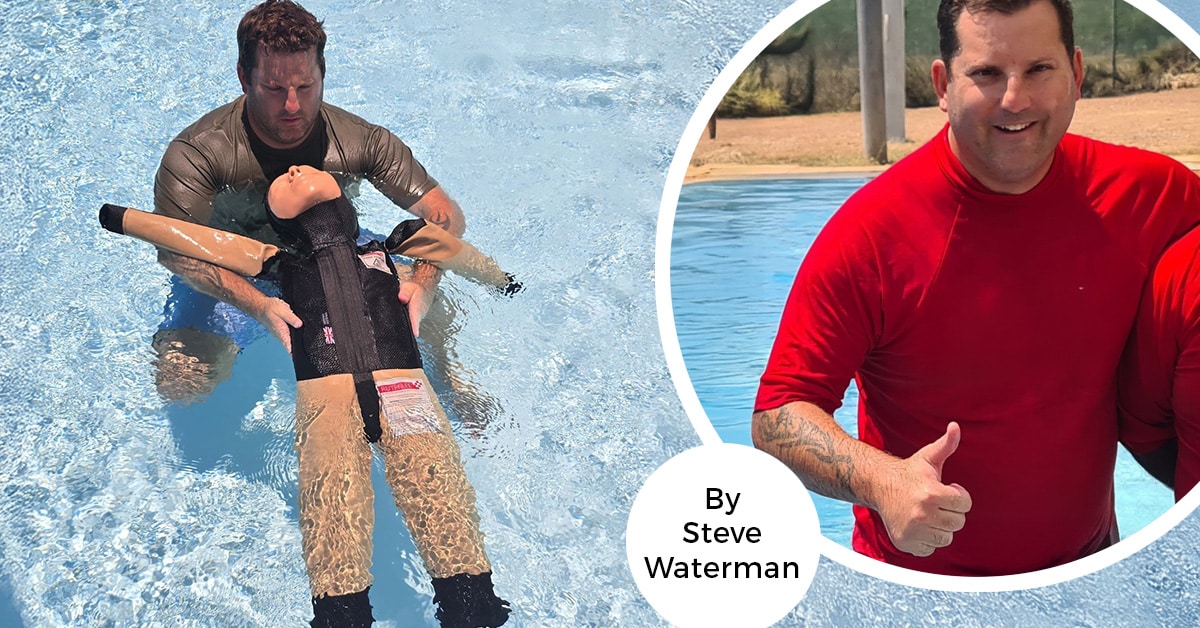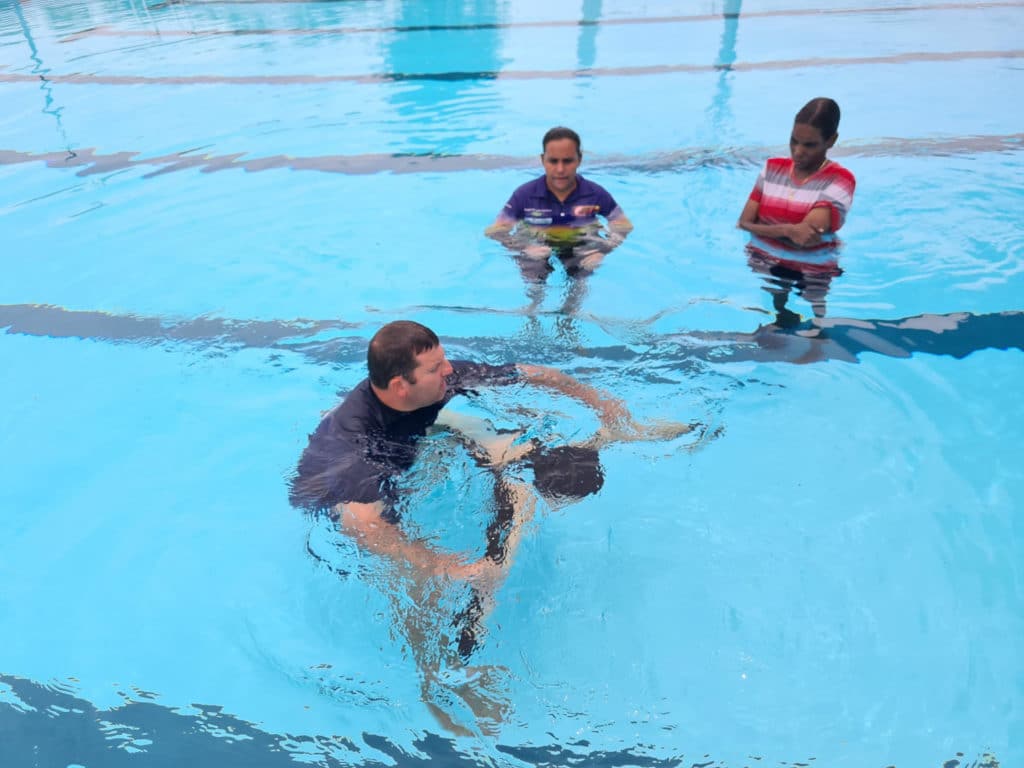Article by Stephen Waterman – Lifeguard Ambassador, Australia
When you picture your role as a lifeguard, you probably imagine vigilance, fast reactions, and strong rescue skills. But here’s a question for you: how confident are you when it comes to supporting swimmers with disabilities?
For many aquatic professionals, this is one of the trickiest aspects of the job. Disabilities come in many forms – mobility limitations, sensory impairments, or cognitive challenges – and each requires us to adapt our communication, equipment, and rescue approach.
The good news? With the right training, you can feel prepared for any situation. And in this article, I’ll share how the Ruth Lee Pool Rescue Manikin has helped me build confidence and sharpen my own skills – including a video where I put it to the test in a retrieval and tow.
The Realities of Assisting Swimmers with Disabilities
Let’s be honest: no two rescues are ever the same. That’s especially true when working with swimmers with disabilities.
- Someone with limited mobility might glide beautifully in the water but need extra flotation or assistance at entry and exit.
- A swimmer with autism or Down syndrome may struggle with verbal instructions, requiring simpler language or visual cues.
- Others may need a buddy system or close support from caregivers.
Safety guidelines are clear – these swimmers are considered high risk, which means our vigilance must be even sharper. But how do you practice for situations like these without putting people at risk?
Why I Trust the Pool Rescue Manikin
I’ve used the Ruth Lee Pool Rescue Manikin in countless training scenarios, from Bronze Medallion assessments to disability-support courses. And I can tell you first-hand – it changes the game.
Unlike plastic dummies or live volunteers, the manikin is:
- Fully weighted and passive – no helpful kicks or adjustments, just like a real unconscious casualty.
- Realistically buoyant – so if your towing technique is off, you’ll know instantly when those legs start to sink.
- Adaptable – perfect for practicing everything from standard retrievals to disability-specific support holds.
This realism doesn’t just test your skills – it builds your confidence. Each successful drill proves to you (and your team) that you really can recover a heavy, non-cooperative casualty. That’s invaluable when you’re supporting swimmers with additional needs.
Key Lifeguard Rescue Techniques You’ll Master
Training with the Pool Rescue Manikin lets you rehearse the essential holds and techniques that every lifeguard must master:
- Passive rescues – supporting under the armpits while towing to safety.
- Spinal precautions – the head-splint hold, keeping neck and spine aligned.
- Two-person lifts – thanks to the manikin’s flexible arms and limbs.
- Realistic airway checks – its human-like face helps trainees remember to always assess breathing and airway.
Personally, I’ve practiced everything from chest and armpit tows to the vice grip roll and extended arm roll using this manikin. Each repetition sharpens technique – and trust me, it’s far tougher than using a willing volunteer.
Manikin vs. Live Volunteers: The Confidence Gap
Here’s the truth: training with a live volunteer just isn’t the same. Volunteers can float, kick, or even subconsciously help you, which takes away from the realism of the drill.
I filmed myself completing a retrieval and tow to compare – and the Pool Rescue Manikin proved far more challenging. Unlike a human participant, it doesn’t breathe in, adjust position, or give you any buoyancy at all. Every bit of flotation and movement has to come from the rescuer.
Meanwhile, lifeguards in the UK have captured another important difference: the manikin makes training smoother and more realistic from start to finish. Traditionally, many courses use a plastic manikin for the underwater retrieval, then swap to a live volunteer floating on the surface for the tow. The result? A disjointed experience that doesn’t reflect how a real rescue would unfold.
In this UK video, you can see two lifeguards completing the same rescue side by side. One follows the traditional method – using a plastic half-torso manikin for the deep-water retrieval and then switching to a live volunteer floating on the surface for the tow. The other uses the Pool Rescue Manikin for the entire scenario, from retrieval to tow to poolside extrication. The difference is clear: the manikin-based rescue is smoother, quicker, and more realistic. By contrast, the switch between manikin and volunteer creates a disjointed process, with the volunteer subconsciously helping during the tow and adjusting themselves at the pool’s edge – actions that make the rescue easier than it would be in real life and ultimately undermine the trainee’s learning.
That’s the real value of the manikin: it’s safe, consistent, and lets lifeguards practise the whole rescue journey, not just isolated parts. Trainers can spot flaws instantly, and every guard faces the same challenge – something you simply can’t achieve with volunteers alone.
Training for Diverse Disabilities
So when it comes to training to support swimmers with disabilities, a lot of adaptability is required. Here are just some ways lifeguards adjust their approach – and how I’ve used the Pool Rescue Manikin to practice these skills:
- Mobility impairments – using floats, ramps, or gentle holds under the ribcage.
- Hearing impairments – relying on taps or visual signals instead of voice.
- Cognitive challenges (autism, ADHD) – practicing calm approaches, non-threatening language, and buddy systems.
- Seizure management – using rescue tubes to support a swimmer mid-convulsion before recovery.
I’m currently working with a swimmer with Down syndrome, and some of the support holds I use with him were first tested on the Pool Rescue Manikin. That practice gave me the confidence to ensure his comfort and safety in the water today.
Practical Tips for Inclusive Lifeguard Training
Here are a few simple, actionable steps you can put into practice at your pool right away:
- Use role play – have staff simulate hearing loss or cognitive challenges to rehearse communication strategies.
- Make time for debriefs – after each drill, discuss what worked and what could improve.
- Build swimmer profiles – note individual needs and strategies for regular patrons.
- Practice end-to-end rescues – from retrieval to poolside extrication, not just isolated steps.
- Collaborate with carers – ask parents, caregivers, or support staff for insights on swimmer comfort and safety.
- Consider upgrading your training manikin – the Ruth Lee Pool Rescue Manikin allows for realistic, end-to-end rescue practice. If you’re in Australia, feel free to contact me or LifeTec for advice. If you’re based elsewhere, reach out to the friendly team at Ruth Lee for details on their award-winning lifeguard training manikin.
These small steps, combined with manikin-based training, make a huge difference in preparedness and confidence.
Beyond Rescues: Building Safer, More Welcoming Pools
Through this experience, I’ve come to appreciate the broader training value of the Pool Rescue Manikin. Beyond its traditional use for retrievals and rescues, it’s a powerful tool for refining support holds and adapting techniques you’ll also use in swim teaching environments, with both adults and children.
But the bigger picture is this: when lifeguards are confident and proficient – not just in standard rescues, but in those specific, sometimes overlooked challenges like supporting swimmers with disabilities – it raises the standard of the entire facility.
Pools that invest in this kind of training build a reputation for being safe, inclusive, and welcoming to all swimmers. Parents notice, disability groups notice, and the community notices. That trust can be just as valuable as any rescue technique – it’s what keeps people coming back.
So, back to the first question: how confident are you in supporting swimmers with disabilities? If the answer is “I could do more,” I encourage you to explore new training methods, practice those niche skills, and yes – make tools like the Pool Rescue Manikin part of your program.
Because every lifeguard deserves to feel confident, every swimmer deserves to feel safe, and every community deserves facilities that put inclusivity at the heart of water safety.
If you’re based in Australia and want advice on getting the most out of your manikin training, I’d love to hear from you. You can connect with me directly on LinkedIn and let’s keep raising the bar for inclusive aquatic safety together.

